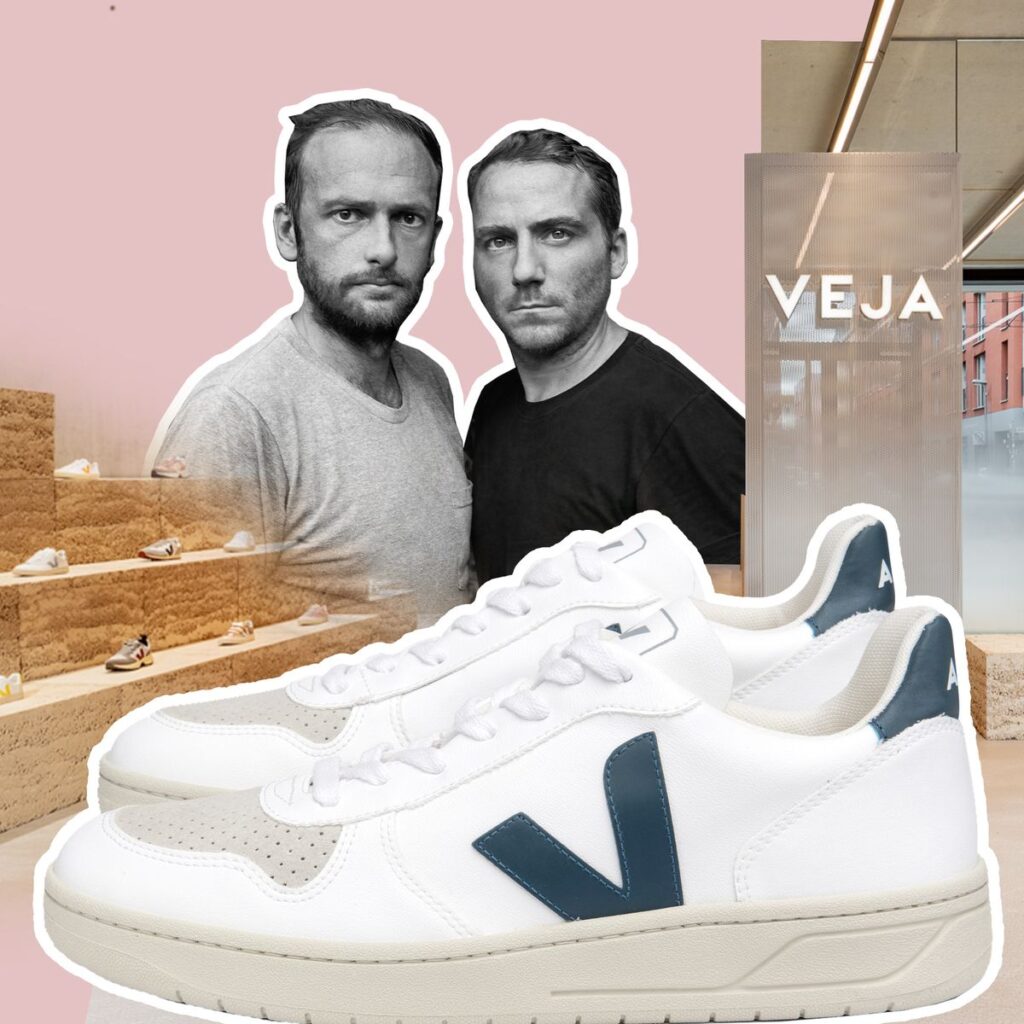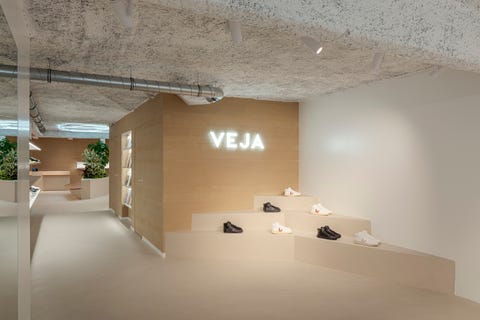Veja Built a Booming Sneaker Brand by Breaking Every Rule – Esquire

|
Getting your Trinity Audio player ready...
|
SOURCE: Mickey Rapkin | Esquire
There’s a funny story about the rise of Veja that turns out to be only half true. I’m standing on a street corner in the once-seedy Pigalle neighborhood of Paris with Sébastien Kopp, co-founder of the hot French sneaker brand, and we’re talking about Meghan Markle. As legend has it, when the Duchess of Sussex was first photographed in a pair of minimalist Vejas—wearing “trainers for the FIRST time on a royal outing,” the Daily Mail shouted—the company’s website crashed.
“The website didn’t crash,” Kopp says, taking a drag on a Marlboro Light. OK, I say. Though I also heard Kopp had no idea who Meghan Markle was.
“My team, yes. Me? No.”
Kopp’s casual attitude toward pop culture (or fashion trends, for that matter) won’t surprise followers of Veja. The sustainable brand, co-founded nearly 20 years ago by childhood friends and one-time bankers Kopp and François-Ghislain Morillion, reported annual sales of $120 million in 2020, up from $78.5 million the year before. But the company, which responsibly sources wild rubber from the Amazon, spends exactly zero dollars on advertising. Veja does not gift products to celebrities either and, as Kopp tells me, they were recently unable to accommodate a request from the costume department at Netflix’s Emily in Paris (it was just too large). Despite its ambivalence (or perhaps because of it) Veja has been embraced by celebrities (Ben Affleck and Eddie Redmayne among them) and the fashion elite alike. Rick Owens did five collaborations with Veja; a second Veja x Marni drop arrives this month.
Kopp, wearing a lived-in army surplus jacket and black Norse Projects pants, was equally lax about Veja’s increasingly global profile: “Every day we receive 10 calls: I’m a banker from J.P. Morgan, my client wants to buy Veja, can we set up a meeting? We don’t answer.” (More on that soon.) With the brand’s 20th anniversary coming up in 2024, one question looms: How did two 25-year-olds (with no experience in fashion) start a sustainable brand with just $10,000 and end up a player in the hyper-competitive sneaker market?
Kopp (whom everyone calls Seb) and Morillion (who goes by Ghislain) met during high school in Paris—two serious-minded economics students. “It was a boring friendship,” Morillion tells me with a smile, standing in Veja’s new-ish store in Montmartre. “It was an intellectual friendship, writing long emails and exchanging ideas.” Kopp, whose parents worked for IBM, recalls the origins of their friendship a little differently: “We were talking about girls, we were talking about parties.”

This much they can agree on: Both took banking jobs abroad out of college and were almost immediately discouraged by the disconnect they saw between corporate talk about sustainability and what these companies were actually doing in the field. So, they quit their jobs and formed an NGO, studying everything from the efficacy of solar panels to the spread of HIV among South African miners. After 18 months, they realized they wanted to launch some kind of sustainable product, identifying a niche in the footwear market. They reasoned: If 70 percent of a traditional brand’s budget is spent on advertising, what if they invested that money in the supply chain instead?
It was a tall order. Neither Kopp nor Morillion knew a thing about design or production. But they put in the work, meeting with rubber tappers in the Amazon’s Chico Mendez Reserve and talking with organic cotton cooperatives in Northeast Brazil. In 2004, they emerged with their first collection—minimalist, canvas sneakers that could be made responsibly. But sustainability was not the selling point they’d imagined. Recalls Kopp: “People said, You’re bothering me with this story about Amazonia and organic cotton.”
“Professional buyers didn’t care,” Morillion says. “They liked the shoe.” Still do. In recent years, Veja has collaborated with boldface fashion names like Mansur Gavriel in addition to Rick Owens and Marni—all incoming calls, Kopp reveals. The first Marni x Veja collection in 2021 looked like a child took a crayon to a pair of Vejas and was an instant hit, like a particularly pleasant acid trip coming out of the pandemic.
Marni’s creative director, Francesco Risso, was drawn to Veja’s core values. But when I ask him if Veja also qualifies as fashion, he doesn’t hesitate: “Fashion is a social movement. Veja represents one of the most modern social movements nowadays. It’s a product that celebrates the old times—because it’s a design that’s similar to basketball sneakers from the seventies and the eighties. But it’s made with techniques of the future, which is materials that are completely sustainable. It’s tapping into the desires of the people moving in the street. That’s fashion.”
From the outside, it’s been a meteoric rise, though Kopp now admits Veja nearly went under a decade ago. The company was selling exclusively through independent shops; when the financial crisis hit Europe, “we had maybe 50 clients selling Veja in the UK, and they all closed without paying.” In 2012, lenders told Kopp: “You are dead.” He pleaded with them: “I said, Give us six months, we will turn around the situation. We started selling online. Then it boomed.”
Kopp and Morillion, both 44, remain equal partners; Kopp leans in on design while Morillion focuses on sourcing. While their lives have taken different turns in the last decade, Veja is as much a story about a lifelong friendship deepening as it is of a business evolving and growing.
Kopp is married with four children. Morillion and his boyfriend recently saw Harry Styles play Madison Square Garden. While Kopp was always the more extroverted one, he has recently noticed himself turning inward. He used to live in the Marais neighborhood, he tells me, but he decided to move after Veja took off. “There were too many people from the fashion industry,” he says. “I was going to buy bread; I was taking two hours.” He and his family now live in the sleepier 5th arrondisement.

Morillion, for his part, will happily monologue on the merits of Veja’s cotton-based leather alternative, or how the seringueiros (or rubber tappers) in the Amazon allow the wild rubber trees to regenerate, or how the cattle industry has sparked deforestation there, pushing Veja to buy leather from the south of Brazil and Uruguay instead. (“We’ve been in a very horrible cycle for the last five years in the Amazon,” Morillion says, though he points out the trouble began before president Jair Bolsonaro famously emboldened bad actors in the region. “It’s not like the devil was unleashed. It’s a progression.”)
And it’s not lip service. In 2019, Veja earned the Fair for Life certification from the French watchdog group, Ecocert, a rigorous process that involves sending an auditor to the Amazon for 20 days to (among other things) interview local workers. As Ecocert’s Consuelo Pereira explains, brands must also pay a living wage and contribute to a development fund earmarked for local communities. When asked if Veja could make its shoes for less money elsewhere, she is quite clear: “If they bought rubber from Malaysia, Indonesia—it would be much, much cheaper.”
But Morillion has other interests beyond the Amazon. He is currently studying for a PhD in philosophy at the Institut Catholique de Paris and teaching an undergraduate seminar on Immanuel Kant (because no one else wanted to teach Kant and the task fell to him). Do his students know he’s the Veja guy? “No,” he says, shaking his head. They didn’t Google him? “Maybe?”
I ask Kopp if his friend is a good teacher. He smiles, saying: “I don’t know. He started last week. I’ve never been to his class. But he’s very good at transmitting. He has a gift.”
What unites these two founders—besides an easy sense of humor born of a 30-year friendship—is perhaps patience. They’ve resisted taking in outside investment, opening only their fifth store this year. As Morillion reveals: “For us, it’s not tempting. Then we’ll have some people at the board that we don’t really want.”
The company has grown to some 500 employees—with about half working out of the Paris headquarters—but it’s still a small business in some ways. During the pandemic lockdowns, Kopp rode around the empty city on his bicycle, checking in on employees and sharing a cigarette, admitting the release was as much for him as it was for them. After two months, he re-opened the warehouse, enlisting a small team of associates to help send out shipments, memorably barbecuing in the parking lot. If you ordered a pair of Vejas during the pandemic, it’s possible Kopp packed them himself.
Veja will mark its 20th anniversary in 2024. When I mention the coming milestone, Kopp says they’ll probably skip the moment entirely. He shrugs: “We are very bad at celebrating.”
.
This article was originally published on Esquire. You can view the original article here.

